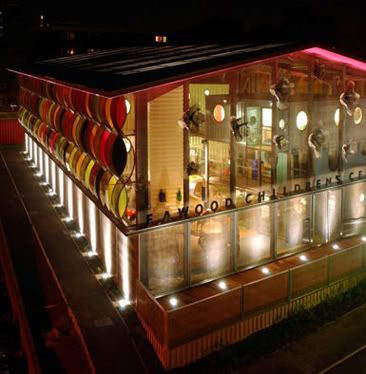
A little over two years ago, a visiting art exhibition was installed in the parking lot next to the Santa Monica Pier. This incredible exhibition, by Gregory Colbert, was entitled Ashes and Snow: it combined photography, art installations, films, and a novel formed in letters, all telling a story about the artist’s travels across the globe. The exhibition traveled from
Using shipping containers to construct relatively permanent structures is a new trend. Although there have been numerous studies and proposals regarding shipping container architecture, few structures utilizing more than a single container have been constructed. One of the first shipping container structures I remember reading about was Future Shack, a home built in
The broad interest in shipping-container architecture is a logical extension of the growing popularity of prefabricated homes, which has spurred many architecture firms and builders to create entire lines of remanufactured units (from efficiency studios to multi-bedroom flats). There are many reasons why using shipping containers as a building modules makes sense. The rigid steel exoskeleton of containers can represent a useful structural unit, recalling how single cells are the building blocks of multicellular organisms. The specifications of shipping containers are determined by the need to move them on rail and on the road. Despite these limitations, the interior dimensions of eight feet high, twenty feet wide, and forty feet long can be transformed to create intimate spaces for living and working.
Since they cost as little as $1,000 for a used unit and $6,000 for a new unit, shipping containers represent a cheap building material; this usually compensates for the costs incurred when using more specialized workers like welders and steel fabricators to alter the containers. Locally, a few examples already exist of new single-family homes built using shipping containers. Architect Peter Demaria designed an award-winning single family home in
Redondo Beach Residence – courtesy of Demaria Architects
Since they are inexpensive, versatile, and easy to transport, shipping containers are already being used in a range of contexts. Indeed, Vanity Fair and Dwell magazines have recently included articles delving further into the topic of shipping container architecture, also known as “cargotecture.” Architects for Humanity, a sort of “Doctors Without Borders” for architecture, has created designs for schools, emergency shelters, health clinics, and even water treatment facilities using shipping containers as a fundamental component. The arts community is a source of innovation in the use of shipping containers, in large part due to their need for cheap studio and exhibition space. For instance, The Shipyard in
We have only seen the surface of what can be done with cargo containers, and
There have been recent discussions about using shipping containers to create temporary arts facilities in downtown
Fawood Children’s Center – courtesy of World Architecture News


